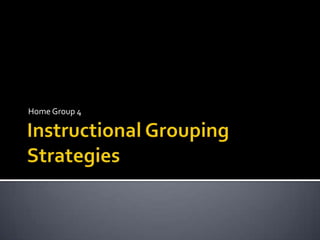
Grouping strategies presentation (Group 4)
- 1. Instructional Grouping Strategies Home Group 4
- 2. Issues/Values Continuum Purpose: to allow students to explore their own opinions about a certain topic or issue Opportunity to explore the diversity of perspectives in the classroom Can be used in a wide variety of classrooms, subject areas, and audiences
- 3. Issues/Values Continuum 1. Select an issue that students have an opinion or perspective about 2. draw a continuum on the board, marking the end points with extreme and opposite sides of the issue Label points along the continuum, such as “strongly agree,” “agree,” “disagree,” and “strongly disagree” 3. Explain labels and markings to students
- 4. Issues/Values Continuum 4. Allow students to signify what they think about the issue by letting them physically place their name on the continuum at the point which most accurately reflects their belief Sticky notes with students’ names are useful
- 5. Issues/Values Continuum 5. Have students who occupy various places along the continuum explain their perspectives and reasoning Allow students to change their minds on the issue and move their name to another spot on the continuum 6. Follow up with in-depth research on the topic, and again allow students to alter their opinions on the continuum
- 6. Taking A Stand Purpose: discuss and deliberate on public policy issues through the use of persuasion and problem solving Can be used with a variety of audiences, but works best with a large classroom
- 7. Taking A Stand Description: Five key steps step 1: present an overview of the issue and opposing side to the class (include examples and relevant details) phrase issue as a question requiring choice/action on part of the students present issue using point/counterpoint format – take student questions etc. step 2: Divide class in half: assign all students a viewpoint (one side of the issue – regardless of their own personal opinion) and have them pair up in their group and share the most important/compelling points on their side of the issue. Select students from each side to share/tell the class these compelling points. 1. Teacher presents main issue or controversy 2. Each student is randomly assigned a role to play in the group discussion and must fulfill that role without regard to the student’s own personal views on the issue Half of the class will be making points for the issue, and the other half will be making counterpoints
- 8. Taking A Stand Description: (cont.) step 3: Encourage students to “go with their own beliefs” Students are allowed to switch sides (move) based on their own opinion – they may go to supporting side, counterpoint side and or middle location in room that represents undecided. After they move have them consider why they did and have them explain reasoning for the move to someone in the same location. Students can continue to move based on these discussions Tip: Teachers should monitor the class and ensure that students remain focused on the issue and its solution
- 9. Taking A Stand Description: (continued) step 4: Encourage interactions and descriptions: Ask 3-4 students on the point side of room to explain strongest argument for standing on that side. After each explanation allow counterpoint students to respond to comments they heard. Allow both sides to present their key arguments then when no new info/ideas are added focus on helping students to answer “What is a solution to this problem/issue” Have each consider pros and cons and have each location/group develop a solution before the class tries to unite these various ideas into one solution to reach some consensus. . 4. After both sides have presented, students can now choose which side of the issue they want to argue for, based on their own beliefs Choose between agree, disagree, and neutral 5. Students pair up and explain the reasoning behind their belief
- 10. Taking A Stand step 5: Dialogical Reasoning Paper: Students write a four paragraph essay about an approved policy/stance of the same or a different issue following the format of the activity Follow-up: Students write a 4 paragraph paper describing what they learned Paragraph 1: state the issue Paragraph 2: describe the point Paragraph 3: describe the counterpoint Paragraph 4: present and explain the solution
- 11. Literature Circle Purpose: engages students in critical thinking and reflection to gain a deeper understanding of a text Allows for student oriented discussions and focuses on finding new insights into a text
- 12. Literature Circle 1. Teacher randomly assign students to small groups of 5-7 students. 2. Students read assigned text. 3. Students meet in groups and discuss what they have read. Include questions, comments, and insights.
- 13. Literature Circle Each student has a role to perform in the group Summarizer: summarizes the main ideas of the text (Summarizes text, main ideas, key issues, plot points etc –keeps everyone on the same page with a consolidated summary) Discussion Director: guides the conversation of the group and keeps the discussion focused on the task. Also cues the illustrator to show/explain image.
- 14. Literature Circle Connecter: connects the text with real world experiences, prior knowledge, and other texts, etc. Literary Luminary: picks out engaging quotes from the text that stand out or have special meaning. Uses these quotes to engage students in deeper discussions/reflections on the lesson or text. Vocabulary Enricher: selects words from the text that are important and have meaning. Creates a list of words to be defined or understood by the group.
- 15. Literature Circle Travel Tracer: helps the group keep track of the story and what is going on. Balances plot and changes in location or themes. Illustrator: creates or finds an illustration that visually portrays the main concepts found in the text. Explains the image to the group.